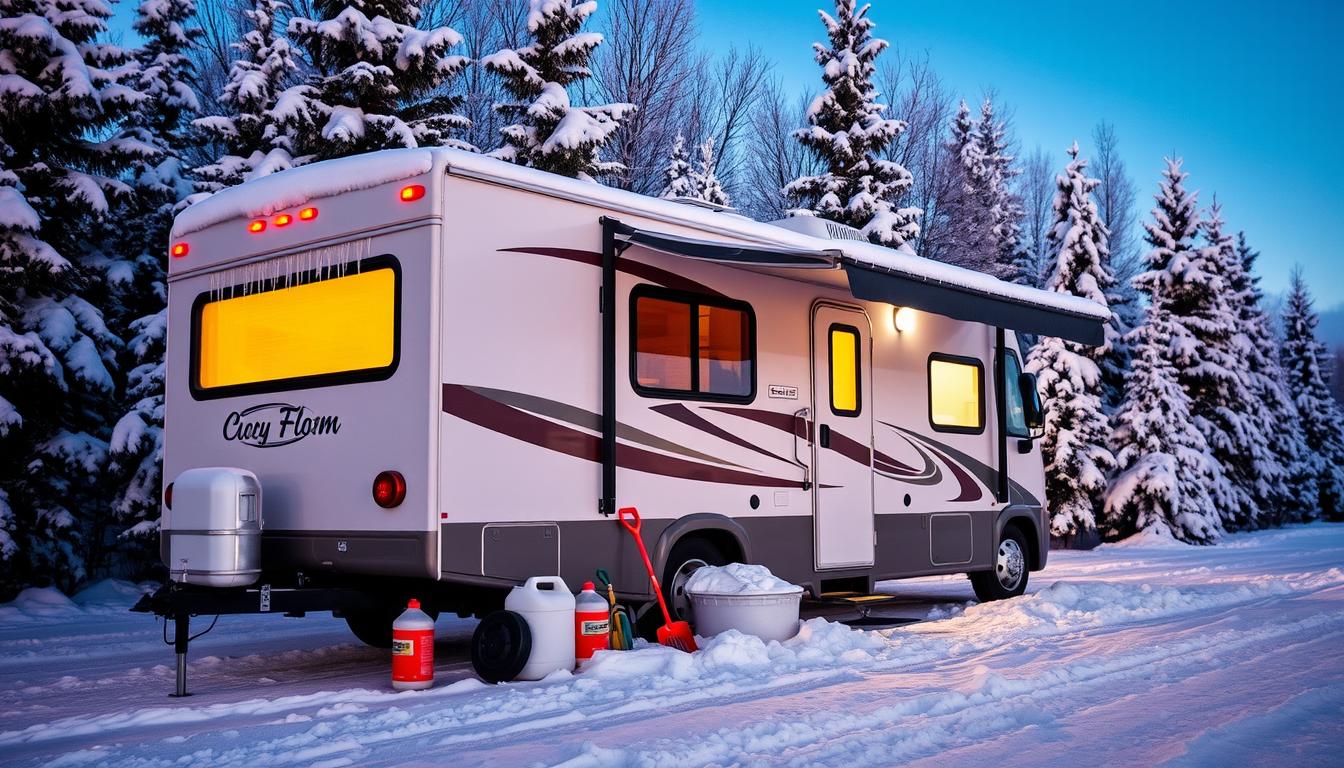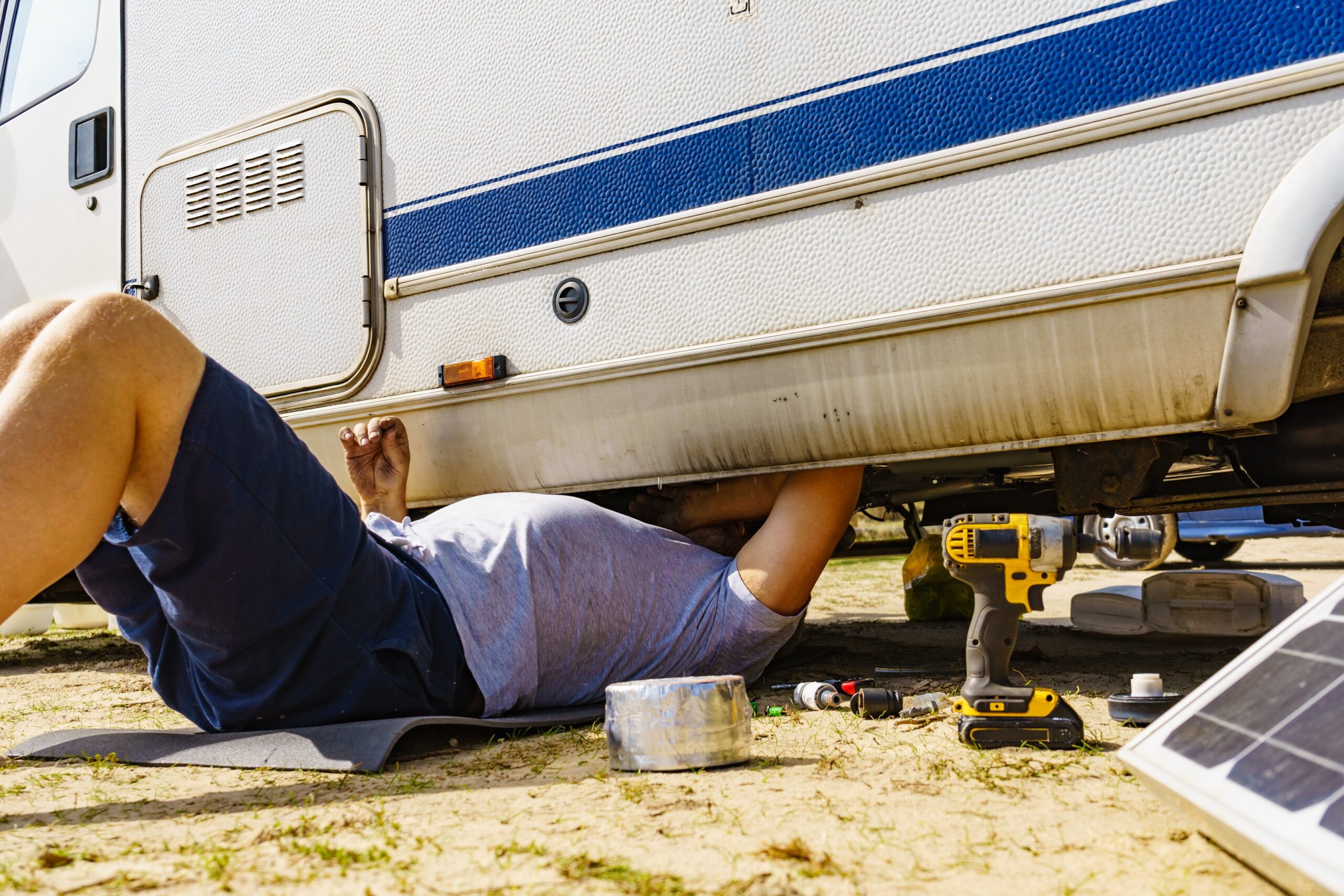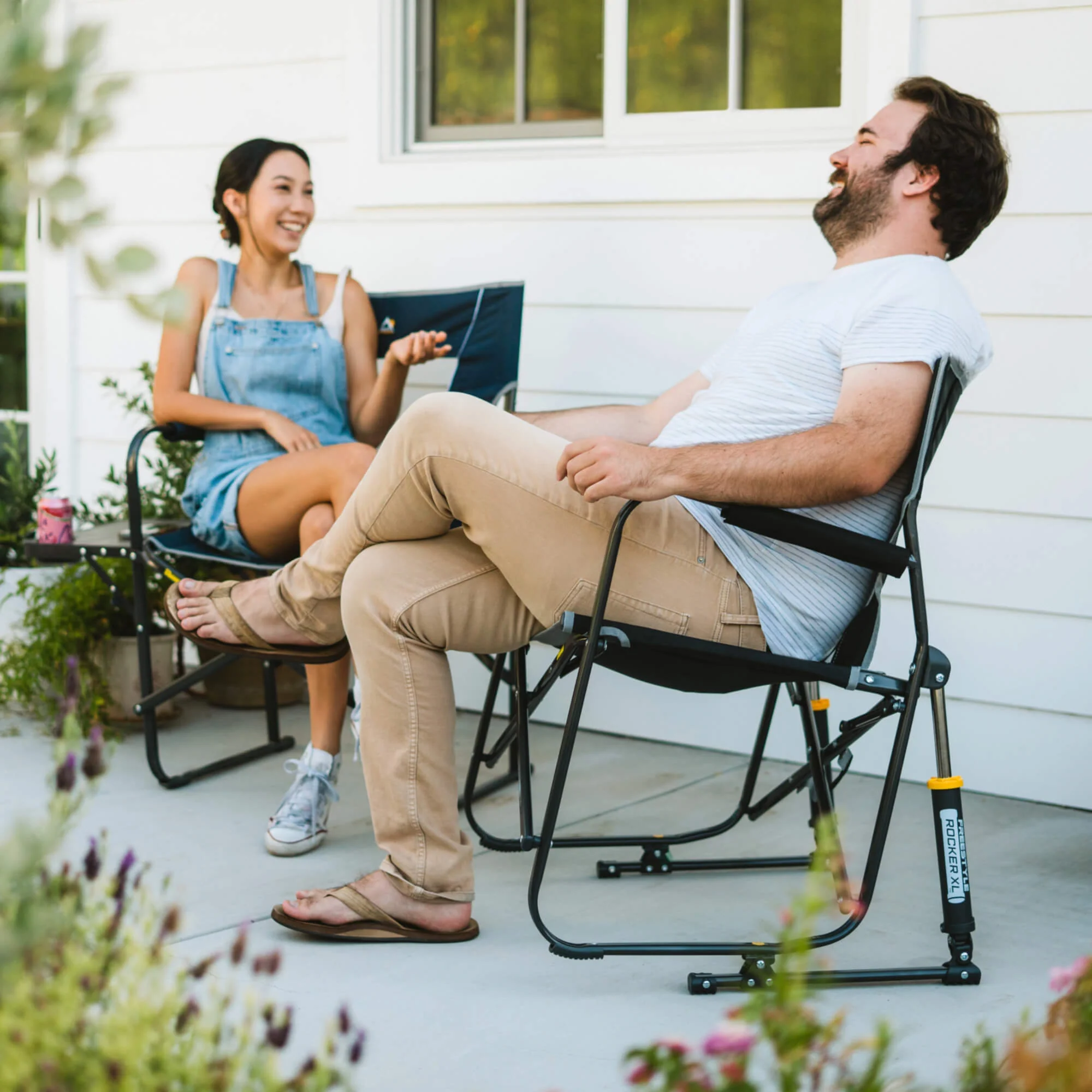RV Winterization: Protect Your Camper for Cold Weather
This page contains affiliate links. If you purchase through them, we may earn a small commission at no extra cost to you. Thank you for supporting RVxTravel!
Did you know water expands by about 9% when it freezes? This can cause pipes in your RV’s water system to leak or burst. Preparing your RV for winter is key to keeping it safe. Using antifreeze in the plumbing system is a common way to prevent damage.
Winterizing your RV means taking several important steps. This ensures your vehicle stays safe and ready for spring adventures. It’s a crucial part of keeping your RV in good shape.
If you don’t winterize your RV, you might face expensive repairs. These costs can be hundreds or even thousands of dollars. Winterizing your RV is especially important if you live in cold areas for more than 24 hours.
Draining water tanks, using antifreeze, and cleaning storage bins are all part of the process. Securing wheel chocks is also important. Doing this now saves you trouble and money later.
Whether you do it yourself or hire a pro, winterizing your RV is worth it. It helps your RV last longer and work better. Taking care of your RV now means you’ll enjoy it more when you’re ready to travel again.
Understanding RV Winterization
What is RV Winterization? It means making sure your RV is ready for cold weather. This includes removing water from lines and tanks. It also means using RV antifreeze to protect the lines.
Why is RV winterization important? It helps avoid expensive repairs and keeps your RV in top shape. Water expands when it freezes, which can burst pipes. Start winterizing your RV before the first freeze to prevent damage.
You’ll need some supplies for RV winterization. These include RV pink antifreeze, a flashlight, towels, and more. Each item is important for protecting your RV from cold.
Draining tanks and blowing out lines are key steps. You also need to push RV antifreeze through the system. Using an air compressor helps remove water from lines.
Not winterizing your RV can cause big problems. It might lead to damaged parts and high repair costs. But, winterizing your RV right keeps it running well for many trips.
Step-by-Step Guide to Winterizing Your RV
When it gets cold, you need to drain your RV’s water system. This means emptying the fresh water tank and flushing the grey and black tanks. It stops damage from freezing.
Make sure to flush the water heater for 2-3 minutes. This removes sediment before you do more.
After draining, let the water heater cool down. This avoids pressure problems. You’ll need 3-4 gallons of RV antifreeze, costing $10 to $30 per gallon.
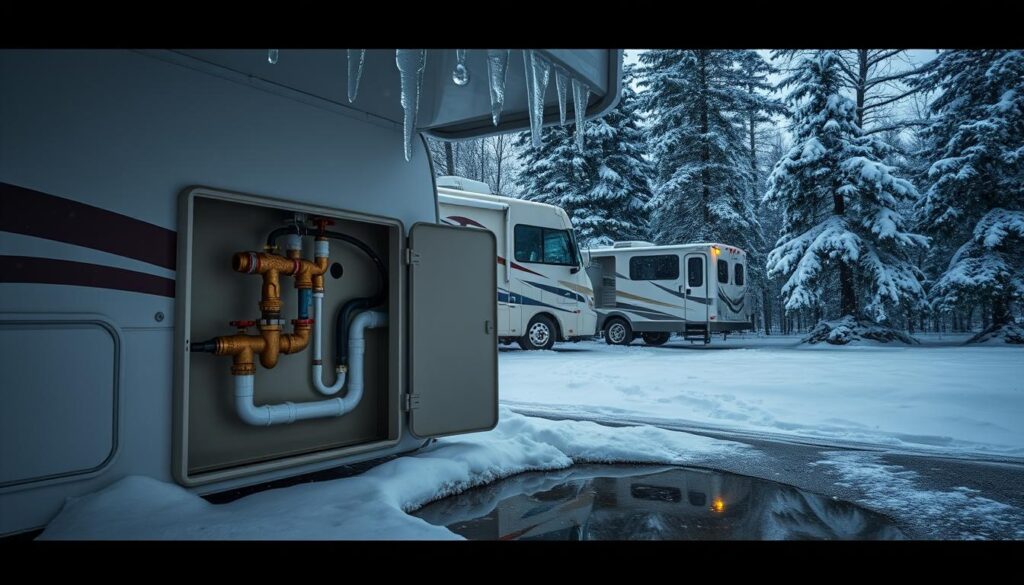
Now, bypass the water heater. This stops antifreeze from getting in. It lets antifreeze flow through the rest of the pipes. Pouring antifreeze down P-Traps keeps pipes from freezing.
Next, protect your RV’s outside. Cover the roof and tires. You’ll also need cleaning supplies and tools, costing $20 to $50. An RV skirt helps keep cold air out.
Finally, insulate your RV’s windows, doors, and vents. This keeps it warm inside and saves energy. With these steps, your RV will be ready for spring.
Essential Tools and Products for RV Winterization
Getting your RV ready for winter is exciting. You need the right tools and products to do it well.
The Camco Permanent Pump Converter Winterizing Kit helps add antifreeze to your plumbing. This stops pipes from freezing and saves you money. The RV Winterizing Kit with Sprinkler Blowout Adapter is also great for emptying pipes.
Use an air compressor at 35-50 psi with a pressure regulator. This keeps your plumbing safe and working well. An air filter keeps debris out of your water lines too.
A shut off valve is key for controlling water flow. It helps prevent leaks and keeps your water system safe during winter. A blowout plug makes it easy to blow out water from your RV’s pipes.
Always add antifreeze to sinks and showers to protect them from freezing. This is a very important step.
Choosing the right antifreeze is crucial. Use RV-specific, non-toxic antifreeze. You’ll need 2-3 gallons, depending on your RV’s size. Ethanol-based and propylene glycol antifreeze are both good, but propylene glycol might be better.
Use a high-quality, weather-resistant sealant around windows and doors. Clean and inspect your RV’s exterior before covering it. Always follow your owner’s manual for specific instructions. With the right preparation, your RV will be ready for winter.
DIY RV Winterization vs. Professional Services
Choosing between DIY RV winterization and professional RV winterization services is a big decision. It depends on cost, ease, and how comfortable you are with the tasks. DIY costs $45 to $165, while pros cost $165 in the first year.
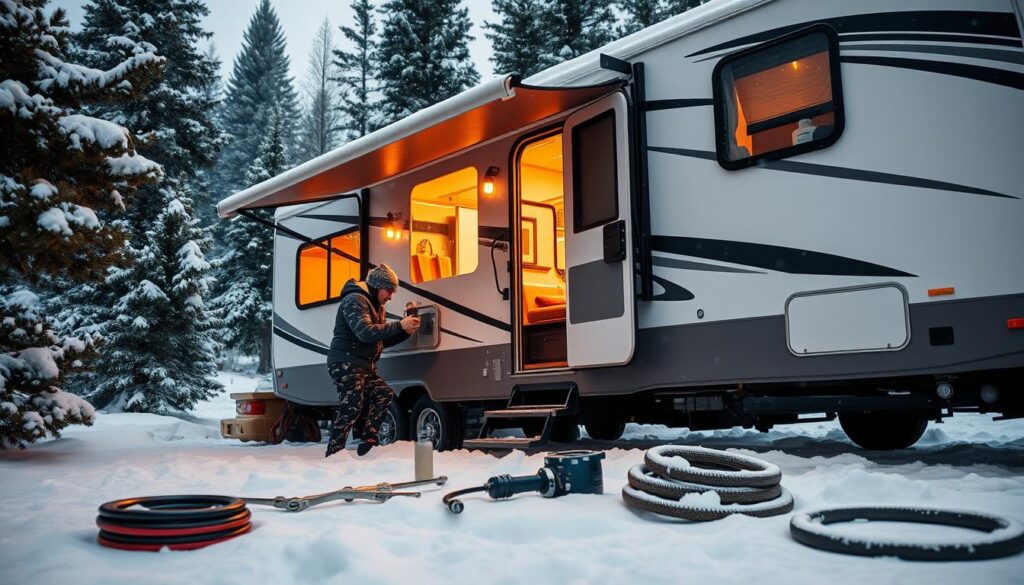
Professional services cost more over time, about $625 in five years. DIY costs $105 to $165 for the first year. Pros ensure a pro handles it, catching issues you might miss.
DIY saves money, especially with tools like antifreeze kits. The first cost is similar, but yearly costs are $15 to $30. It takes a half-day, needs dedication, and knowledge of RV systems.
Choosing DIY or pros depends on your time and money. If you want to save and are handy, DIY is great. For ease, go with pros.
Conclusion
As we finish our guide on RV winterization, it’s clear this step is key. It keeps your mobile home safe and sound in the cold. Preparing your RV for winter protects it from water damage and keeps systems working.
By winterizing your camper safely, you’re ready for new adventures in the spring. Your RV will be in top shape.
The work you do to get your RV ready for the cold helps it last longer. Use antifreeze to stop pipes from freezing. Make sure propane tanks are full or removed for the cold.
A fully charged 12-volt battery is also important. Move your RV often to keep tires even. You can spend about $100 on supplies, which is cheaper than hiring a pro.
Getting your RV ready for the cold is more than just surviving winter. It’s about being ready for fun adventures when it’s warm again. Winterizing your camper safely keeps everything in great shape.
This means you and your RV are always ready for the road. You can explore with confidence.
Source Links
- Winterize Your RV: A Step-By-Step Guide – https://americasrvwarranty.com/winterize-your-rv-a-step-by-step-guide
- Here’s Everything RV Owners Should Know about RV Winterization – https://www.gorving.com/tips-inspiration/how/heres-everything-rv-owners-should-know-about-rv-winterization
- How To Winterize an RV – https://www.progressive.com/lifelanes/how-to-winterize-an-rv/
- How to Winterize Your RV in 9 Simple Steps – https://www.rvezy.com/blog/how-to-winterize-rv
- How To Winterize Your RV the Right Way – https://www.amfam.com/resources/articles/hobby-and-recreational-vehicles/how-to-winterize-your-rv
- How to Winterize Your Camper or RV – https://www.gagscamperway.com/rv/winterize.htm
- How to Winterize an RV [Step-by-Step Guide] – https://reolink.com/blog/how-to-winterize-an-rv/?srsltid=AfmBOoqf_leqqwkoZBS54fUym9LkNkHTvRMQbca6YHvMNKscjdCytr54
- How To Winterize Your RV – https://blog.campingworld.com/learn-to-rv/how-to-winterize-your-rv/
- Basic Supplies for RV Winterization – https://www.winnebago.com/lifestyle/winnebagolife/life/basic-supplies-for-rv-winterization
- How to Winterize an RV (12 Point Checklist Included) – https://boltstorage.com/post/how-to-winterize-an-rv
- How to Winterize a Camper: Tips & Tricks | TAXA Outdoors – https://taxaoutdoors.com/blogs/articles/how-to-winterize-camper?srsltid=AfmBOooj6bNl6YWcYgcVqNI-jij0DXoEcZx6dzzmdh9vWuKrJ0J8-U1i
- Guide to Winterizing an RV. | RV Like a Pro – https://rvlikeapro.com/?p=191
- How to Winterize an RV – Leisure Coachworks – https://leisurecw.com/how-to/how-to-winterize-an-rv/
- Winterize Your RV – 10 Tips for Closing Up Shop – RV – https://www.michiganrvandcampgrounds.org/winterize-your-rv-2/
- How to Winterize an RV [Step-by-Step Guide] – https://reolink.com/blog/how-to-winterize-an-rv/?srsltid=AfmBOoo4NS1ttaY6hjebNPJMaTaNgnJuwinZe5YcgMVdZyZWFR4wZq95

